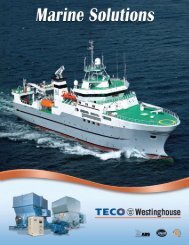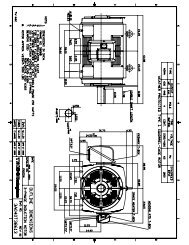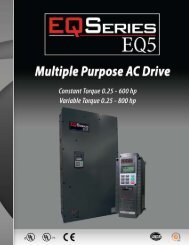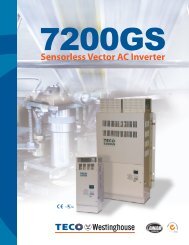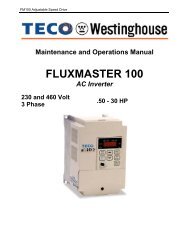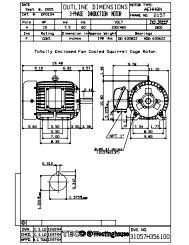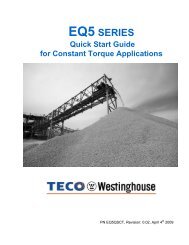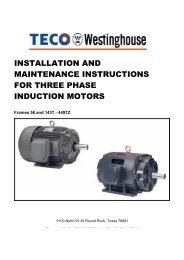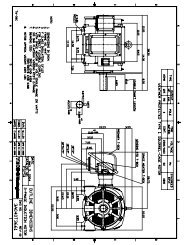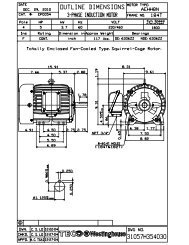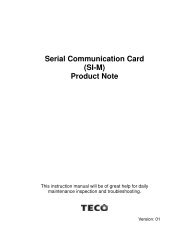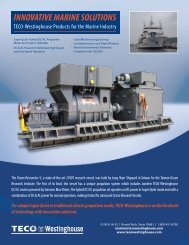EQ7 Series Instruction Manual - TECO-Westinghouse Motor Company
EQ7 Series Instruction Manual - TECO-Westinghouse Motor Company
EQ7 Series Instruction Manual - TECO-Westinghouse Motor Company
You also want an ePaper? Increase the reach of your titles
YUMPU automatically turns print PDFs into web optimized ePapers that Google loves.
Chapter 9 Using PID Control for Constant Flow / Pressure Applications<br />
9.1 What is PID Control?<br />
The PID function in the <strong>EQ7</strong> drive can be used to maintain a constant process variable such as pressure, flow,<br />
temperature by regulating the output frequency (motor speed). A feedback device (transducer) signal is used to<br />
compare the actual process variable to a specified setpoint. The difference between the set-point and feedback<br />
signal is called the error signal.<br />
The PID control tries to minimize this error to maintain a constant process variable by regulating the output frequency<br />
(motor speed).<br />
PID Control<br />
Cancellation<br />
(E01 – E07 = 20)<br />
F01 Frequency<br />
Command 1<br />
PID Command<br />
Selected by<br />
J02 (0 Default)<br />
0: Keypad (Default)<br />
*<br />
Terminals:<br />
1: 12- 0-10VDC<br />
1: V2 – 0-10VDC<br />
1: C1 – 0-20mA<br />
3: Up/Down<br />
4: Communication<br />
+<br />
-<br />
Proportional Gain<br />
(0.000 - 30.000)<br />
J03<br />
Integral Time<br />
(0.1 - 3600.0 Sec.)<br />
J04<br />
Derivative Time<br />
(0.00 - 600.00 Sec.)<br />
J05<br />
+<br />
+<br />
+<br />
PID OFF<br />
Normal<br />
Operation<br />
Inverse<br />
Operation<br />
Dancer<br />
Control<br />
J01 PID Control<br />
OFF<br />
ON<br />
*Terminal<br />
12<br />
Feedback Filter<br />
(0.0 - 900.0 Sec.)<br />
PID Control Block Diagram<br />
0<br />
1<br />
2<br />
3<br />
J06<br />
Normal<br />
Operation<br />
Frequency<br />
Command<br />
Terminal 12<br />
E61 = 5<br />
Drive<br />
Section<br />
PID Feedback Signal<br />
Terminal C1<br />
E62 = 5<br />
Terminal V2<br />
E63 = 5<br />
Feedback<br />
Transducer<br />
E61, E62 or E63 = 5<br />
Feedback Signal Select<br />
* The setpoint and feedback sources<br />
cannot be the same terminals.<br />
Control<br />
Target<br />
*<br />
The amplitude of the error can be adjusted with the Proportional Gain parameter J03 and is directly related to the<br />
output of the PID controller, so the larger gain the larger the output correction.<br />
Example 1: Example 2:<br />
Gain = 1.0 Gain = 2.0<br />
Set-Point = 80% Set-Point = 80%<br />
Feedback = 78% Feedback = 78%<br />
Error = Set-point - Feedback = 2% Error = Set-point - Feedback = 2%<br />
Control Error = Gain x Error = 2% Control Error = Gain x Error = 4%<br />
Please note that an excessive gain can make the system unstable and oscillation may occur.<br />
The response time of the system can be adjusted with the Integral Gain set by parameter J04. Increasing the Integral<br />
Time will make the system less responsive and decreasing the Integral Gain Time will increase response but may<br />
result in instability of the total system.<br />
Slowing the system down too much may be unsatisfactory for the process. The end result is that these two<br />
parameters in conjunction with the acceleration (F07) and deceleration (F08) times (see chapter 8.2) are adjusted to<br />
achieve optimum performance for a particular application.<br />
For typical fan and pump applications a Proportional Gain (J03) of 2.0 and an Integral Time (J04) of 5.0 sec is<br />
recommended.<br />
9-1



